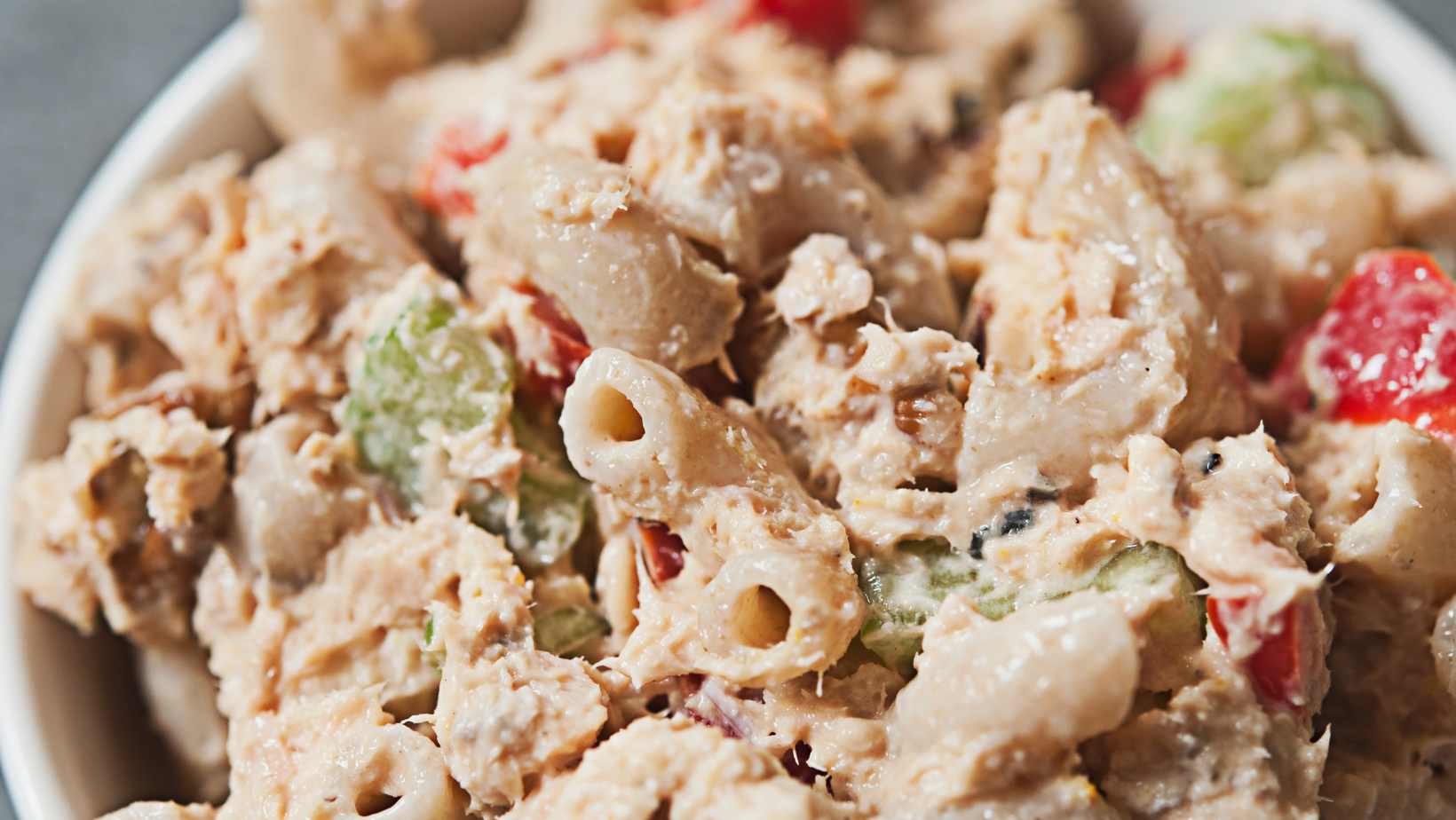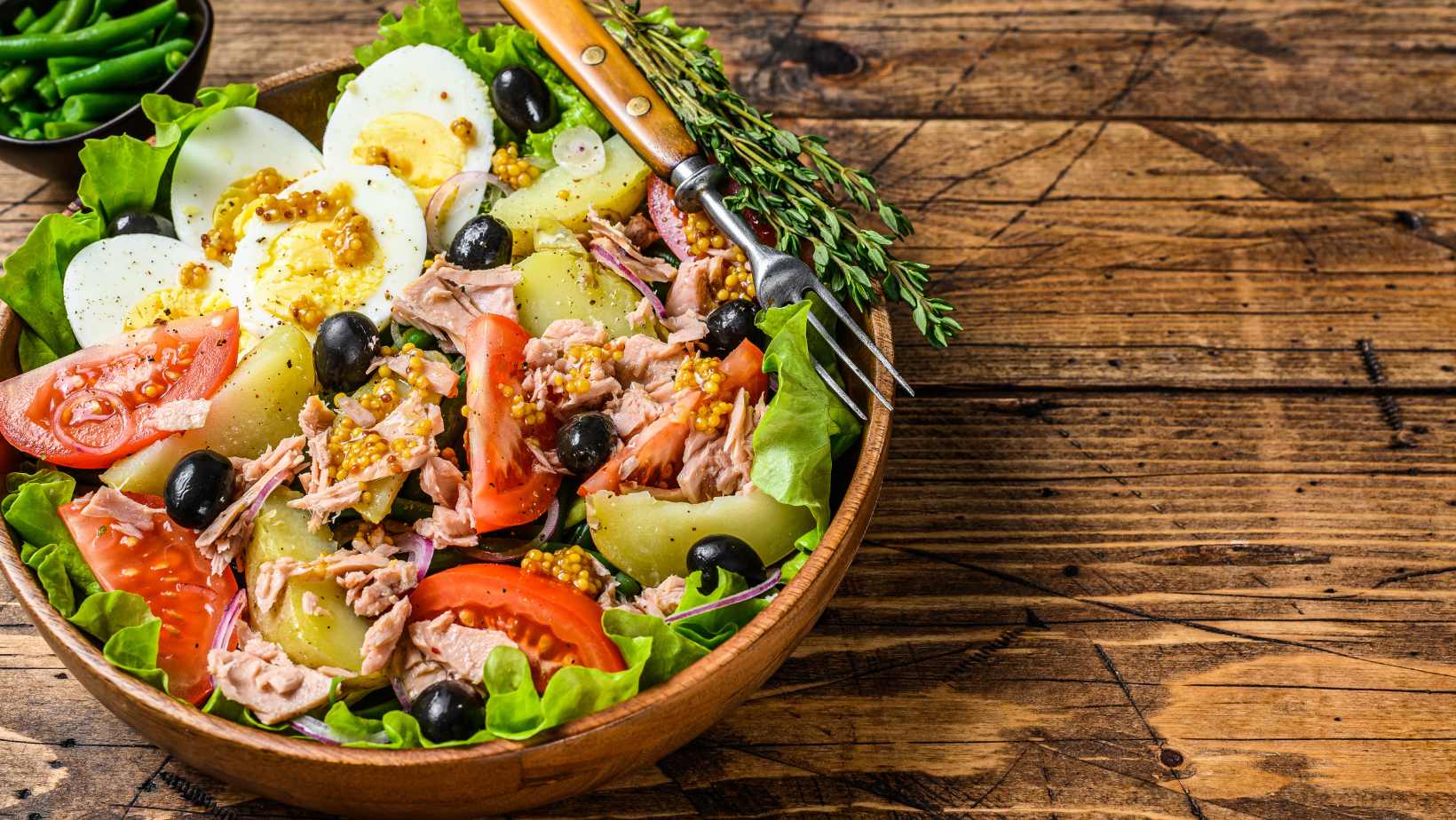To better understand how long tuna salad can last in the fridge, you need to know its shelf life. Understanding the shelf life of tuna salad is a crucial step in ensuring that the food you’re consuming is fresh and safe for consumption. In this section, we’ll explore the various factors that affect the shelf life of tuna salad.
How Long Does Tuna Salad Last in Fridge
Storing tuna salad correctly is key. It depends on how it’s prepared, the ingredients used, and storage method. Refrigerate it in a sealed container for best results. Usually, it’ll last 3-5 days. Be sure to check the expiry date before eating. Adding mayonnaise or eggs can mean a shorter shelf life. Without perishable ingredients, it can last up to 5 days. The USDA says: if food is above 40°F for 2+ hours, there’s a risk of foodborne illness. So, if your tuna salad starts singing ‘Under the Sea’? Toss it out!
Signs That Tuna Salad is Going Bad
To determine if your tuna salad has gone bad, examining its appearance and texture, and checking for unusual odour and taste are important steps. This section on “Signs that Tuna Salad is Going Bad” with sub-sections “Examining the appearance and texture of tuna salad” and “Checking for unusual odour and taste” will help you identify the signs of spoilage in your tuna salad and prevent you from consuming it beyond its expiry date.
Examining the Appearance and Texture of Tuna Salad
Tuna salad can go bad. To check if it’s safe, sniff it. If it smells bad, it’s a clear sign that it’s not safe to eat.
Also, check the texture. If it’s slimy or mushy, it’s time to throw it out.
If it’s discoloured or has mould on it, it’s time to get rid of it.
I remember once I made a big bowl of tuna salad for a family party. I didn’t store it properly and the next morning it had gone bad. There was a nasty smell and slime and mold on the surface. Since then, I take extra care when storing food.
Trust your nose – if it smells like a tuna graveyard, say goodbye to that salad!
Checking for Unusual Odour and Taste
Checking for any Unusual Scent and Flavor
When it comes to making sure tuna salad is fresh, we must be aware of its smell and taste. These are good indicators to assess the quality. Here are 3 signs that help you identify if tuna salad has gone bad:
- Off Odour: If there’s a rancid or sour smell, the fish is bad.
- Bitter Taste: A bitter or metallic taste could mean the dressing has spoiled.
- Mouldy Appearance: Visible mould means it’s past its prime.
It’s important to recognize these signs, since eating expired tuna salad could lead to food poisoning.
Aside from these indicators, there are other ways to protect yourself against any health risks. The colour is another way to detect spoilage, and it should stay natural. If liquid dressings are cloudy, don’t serve them.
It is essential to look out for abnormalities, since they show something has gone wrong while preparing tuna salad or storing it. If unsure how long a dish has been in the fridge, follow your gut and throw it out.
Now that you know what makes fresh tuna salad different from contaminated ones, take the necessary precautions while preparing this delicacy at home!
Factors That Affect Tuna Salad Shelf Life
To understand how long your tuna salad can last in the fridge, knowing the factors that affect its shelf life is key. In order to help you with this, this section on ‘Factors That Affect Tuna Salad Shelf Life’ with sub-sections ‘Impact of storage temperature on tuna salad shelf life’ and ‘The role of preservatives in extending the shelf life of tuna salad’ will provide you with important insights to ensure you practise proper food safety measures and reduce the risk of illness.
Impact of Storage Temperature on Tuna Salad Shelf Life
Maintaining the right temperature for tuna salad is essential to keep it fresh. High temperatures will ruin its quality, flavour, and texture. So, ‘The Impact of Maintenance of Appropriate Storage Temperature on Tuna Salad Shelf Life’ is key.
A table can show the influence of different temperatures. At 40°F, shelf life increases from two days at 50°F to five. At 32°F or below, it lasts up to seven days. But at room temperature (72°F), it lasts only one day.
Preservatives, like vinegar and lemon juice, in the dressing can keep the salad fresh. Also, an air-tight container helps extend its shelf life. By following food preservation techniques at the right temperature, the product’s longevity improves.
A study in Food and Bioprocess Technology shows that taking the right steps can increase ready-to-eat food shelf life without affecting its quality.
The role of preservatives in extending the shelf life of tuna salad
Preservatives are essential for extending the shelf life of tuna salad. Examining what these preservatives consist of helps to attain the best shelf life possible.
Common preservatives used in tuna salad include:
- Citric Acid: Retards bacterial growth.
- Potassium Sorbate: Inhibits mould and yeast development.
- Sodium Benzoate: Kills microorganisms and stops further activity.
However, merely including preservatives in tuna salad isn’t enough. It’s necessary to comprehend the ideal mix of elements, processing processes, packaging materials, and storage conditions to get the most out of shelf life.
Never miss out on the ideal preservation techniques. Make sure your tuna salad stays fresh by utilising proper refrigeration, monitoring expiration dates, and making sure safe preparation practices.
The 3 C’s should be considered when storing tuna salad – Cool, Covered and Consumed before the expiration date – or risk the consequences.
Tips For Storing Tuna Salad
To ensure your tuna salad stays fresh for longer, learn the proper storage techniques for tuna salad and reuse your leftover tuna salad creatively. These are the subsections that will provide the answers you need.
Proper Storage Techniques for Tuna Salad
To preserve tuna salad’s freshness and taste, follow the right storing practices. Refrigerate it always and keep it in the coldest part of the fridge. Securely wrap or store it in air-tight containers. And don’t keep uncovered food items in direct contact with your tuna salad. Plus, consume or freeze it within three days of preparation.
Remember, food safety is as crucial as storing it properly! The USDA says it should be kept below 40°F (4°C). Who knows what kind of regret you’d experience if you didn’t?”
Reusing Leftover Tuna Salad
Creative Ways to Reuse Leftover Tuna Salad!
Be creative and careful when transforming leftover tuna salad. Here are 3 ideas:
- Pizza Topping – Spread the tuna on top for movie night!
- Stuffed Sandwiches – Use defrosted bread slices and fill with tuna, lettuce & tomato.
- Tuna Melt – Top crispy bread slices with tuna salad, and melt cheese in the oven.
Mix in some extra dressing or herbs for added flavour. Remember, cooked food has a max shelf-life of 5 days.
Fun Fact: In 2019, a restaurant in Japan served a $6,000 can of tuna fish! Yikes! Better not risk expired tuna salad…
Risks of Eating Expired Tuna Salad
To understand the risks of eating expired tuna salad, you need to know about the different health hazards associated with it. This section, on `Risks of Eating Expired Tuna Salad`, with `Recognizing the health risks of consuming bad tuna salad` and `Prevention methods to avoid food poisoning from tuna salad` as sub-sections, will help you learn about the adverse impacts of consuming bad tuna salad and how you can prevent food poisoning from it with some precautions.
Recognizing the Health Risks of Consuming Bad Tuna Salad
Expired tuna salad can be a health hazard! Pathogens like bacteria and mould can grow in the fish, and cause food poisoning or stomach issues. Symptoms can include vomiting, cramps, diarrhoea, and fever. It’s important to watch out for changes in smell or appearance. Eating bad food can have serious, long-term effects.
To make sure your tuna salad is safe, store it in airtight containers in a cool place. Canned or packaged tuna should be eaten within two years of purchase, and prepared salads within three to five days.
It’s not just about detecting mould or bad smells. You need to know how foodborne illnesses develop, and take the necessary precautions. The FDA warns that fake fish is entering the US seafood market. So, don’t let a can of tuna salad send you to the bathroom all day – play it safe!
Prevention Methods to Avoid Food Poisoning From Tuna Salad
Food safety for tuna salads? Here are a few tips!
- Use your senses to buy fresh ingredients
- Be cautious when storing
- Pay attention to expiry dates
- Practice cleanliness and cook properly
- Plus, 90% of food poisoning cases are due to cross-contamination – so keep your tuna salad safe and your digestive system even safer!

Safe Practices For Tuna Salad Consumption
To ensure safe consumption of tuna salad, it’s crucial to follow certain guidelines. In order to keep up with the latest safe practices for tuna salad consumption, this section with “Safe Practices for Tuna Salad Consumption” with “Guidelines for consuming unpreserved tuna salad” and “Safe storage practices to prevent the growth of bacteria” as solutions is all you need. Let’s dive into these subsections to learn more!
Guidelines for Consuming Unpreserved Tuna Salad
If you’re after advice on consuming tuna salad that isn’t preserved, there are certain guidelines you should follow. This is for the health of everyone who eats it.
- Ensure the tuna is cooked before adding it to the salad.
- Don’t use mayo or dressings left out at room temp. for more than two hours.
- Keep the unpreserved salad in an airtight container and cool until served.
- Only add ingredients that have been freshly washed.
- Eat the unpreserved tuna salad within two days of making it.
If nausea or diarrhoea occur, seek medical attention!
Tuna itself is generally safe, but tuna salads have caused food-borne illness. So, keep safety in mind when cooking and eating any type of meal. Store the tuna salad correctly and avoid a seafood disaster!
Safe Storage Practices to Prevent the Growth of Bacteria.
Protect yourself from dangerous bacteria in Tuna salad! Hygienic habits are essential for reducing bacterial contaminants that can cause harm.
Take these three steps for safe eating:
- Freeze raw tuna before use. Then, refrigerate or freeze the salad immediately after adding ingredients.
- Keep serving sizes small, and don’t leave the dish out longer than two hours.
- Wash hands, utensils, and surfaces during preparation and disposal.
Check expiration dates on ingredients, and keep different salads away from each other in the fridge to avoid cross-contamination.
Tuna salads have been around since early 1900s America. The rise of canned tuna made it a popular lunchbox item for all social classes.
















































